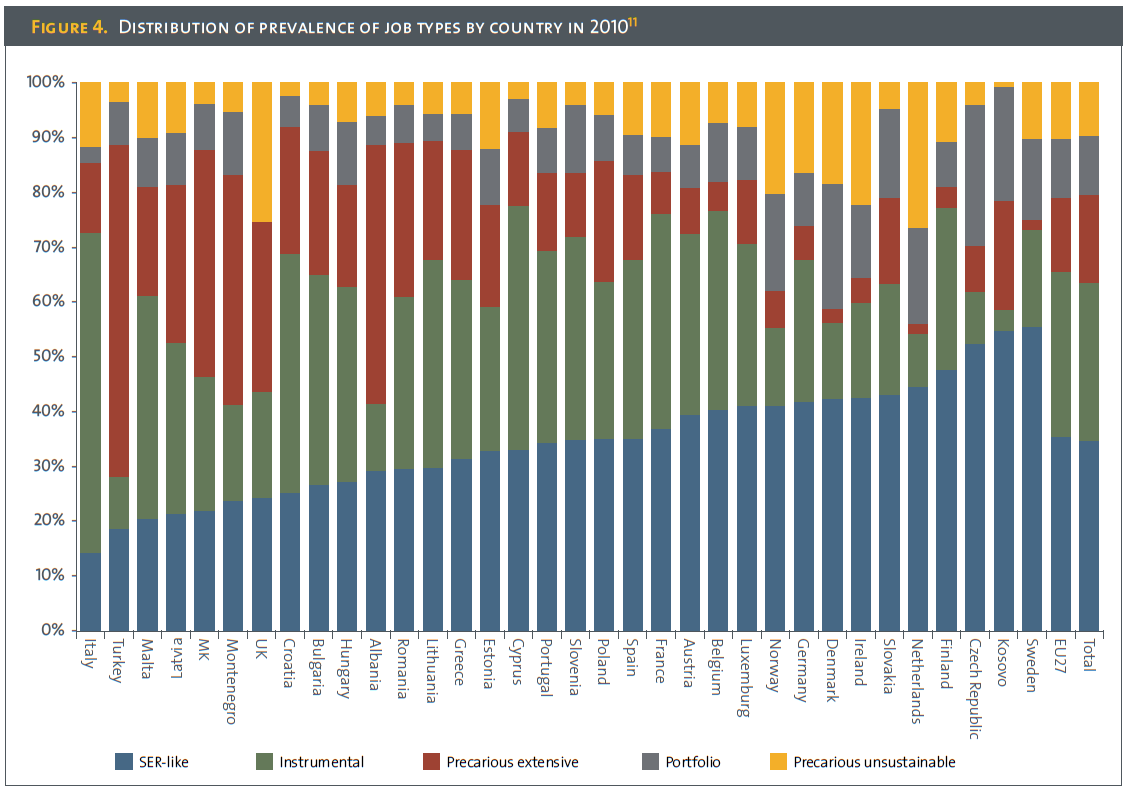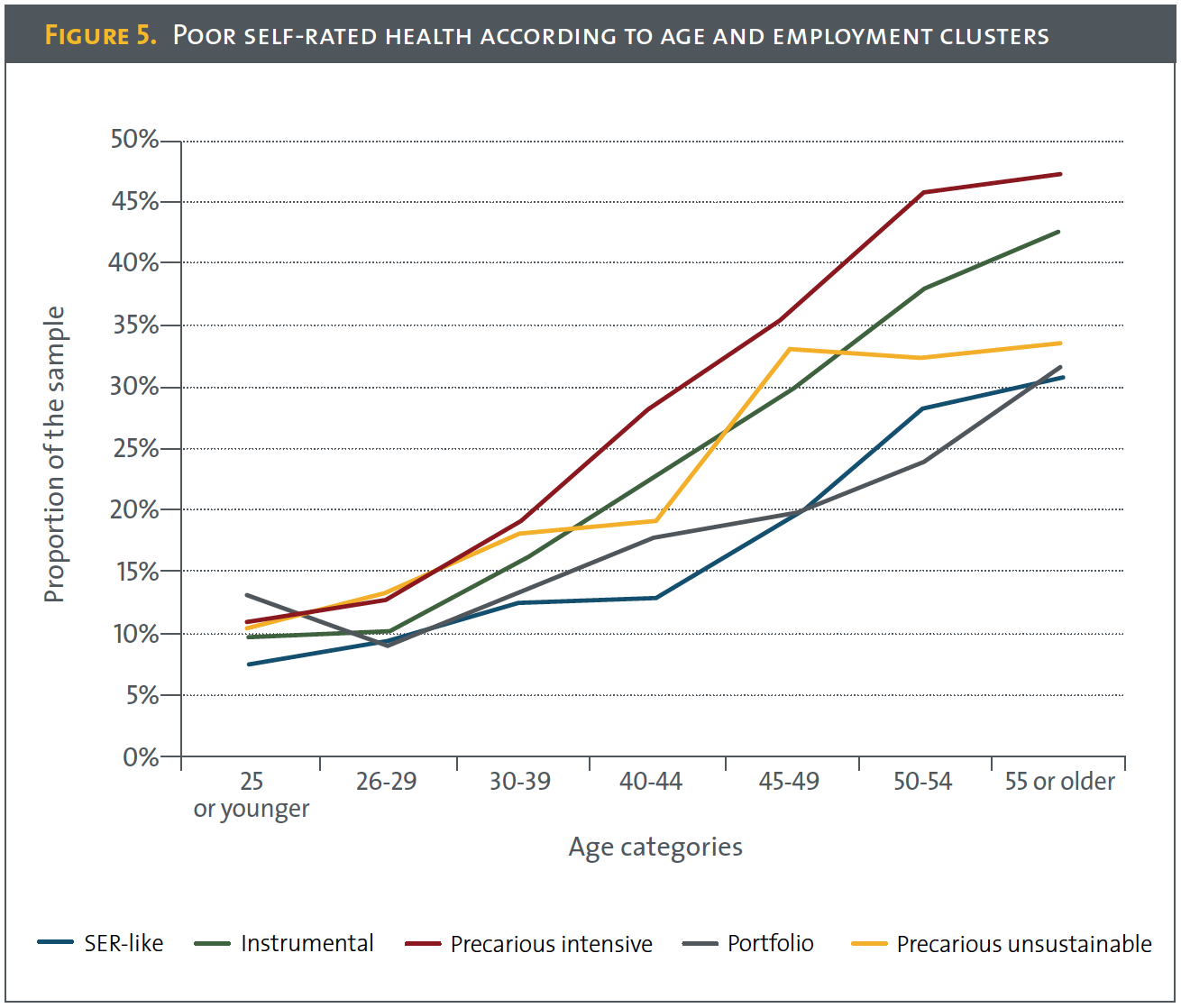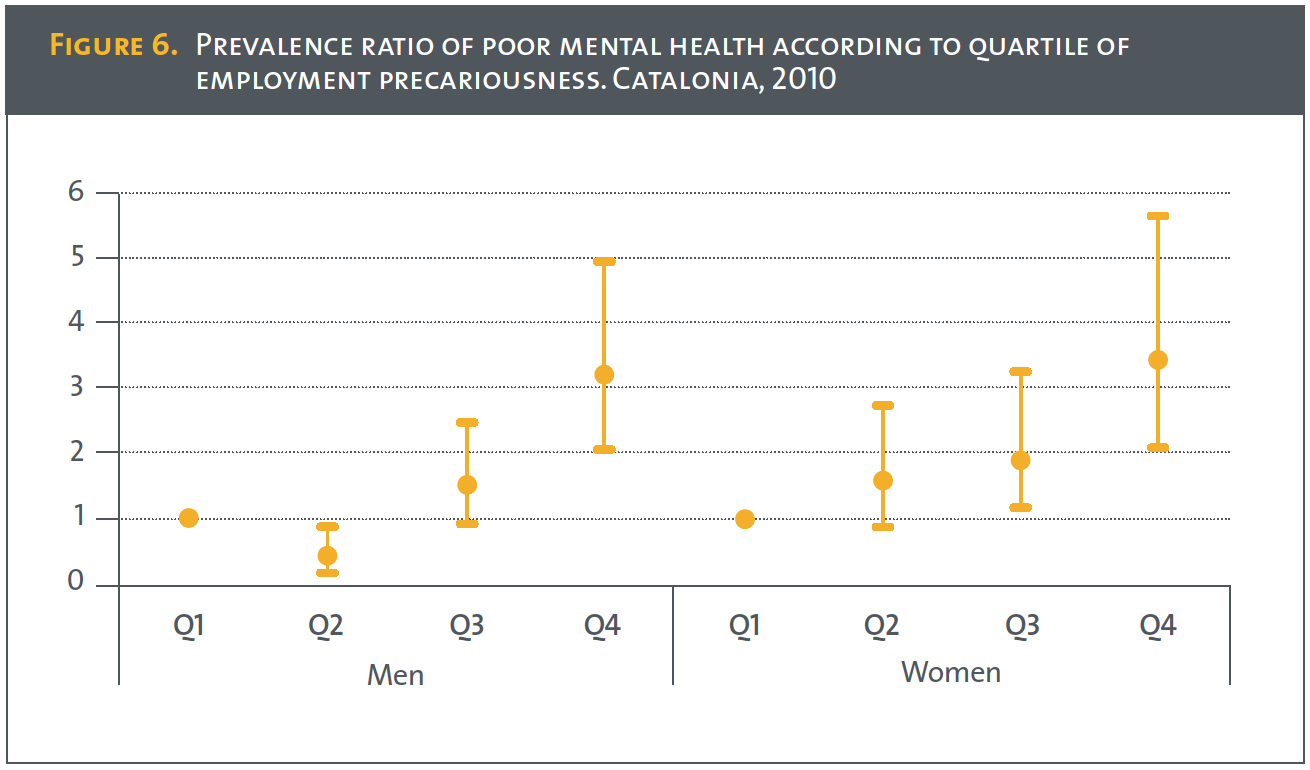Labour market

Declining quality of employment causes a serious threat to health for workers in contemporary labour markets. Nevertheless, some situations like employment precariousness or informal employment are not well conceptualised and measured leading to unsatisfactory estimations of their impact on health. Labour market policies can play an important role with regard to the quality of employment, but little is known about potential differences in the association between the quality of employment and health in different national and political backgrounds.
Main findings
Surveys are useful for monitoring employment conditions and their impact on work-related health (inequalities), but they must be strongly improved
Factors which determine the quality of employment in Europe can be summarised in terms of five job types with special attention to their employment quality (3): SER-like (similar to the standard, idealised employment relationship; Instrumental (relatively stable but with few benefits); Portfolio (highly skilled but rather flexible); Precarious unsustainable (characterised by adverse employment conditions and relationships); and Precarious intensive (shows the most adverse scores, especially in regards to work intensity and high flexibility). Precarious employment is far broader than would be suggested by simple dichotomies between standard and non-standard employment. This employment type constitutes an important social determinant of health in contemporary labour markets (2). Precarious and informal employment definitions differ across countries (3,4,6). Precarious employment should be studied using a common definition with a multidimensional perspective (2); informal employment should be conceptualised and measured with reference to the level of informality (6) and social protection (7).
(1). Benach J, Puig-Barrachina V, Vives A, et al. The challenge of monitoring employment-related health inequalities. J Epidemiol Community Health. 2012; 66:1085-7.
(2). Benach J, Vives A, Amable M, et al. Precarious employment: understanding an emerging social determinant of health. Annu Rev Public Health. 2014; 35:229-53
(3). Van Aerden K, Moors G, Levecque K, et al. Measuring Employment Arrangements in the European Labour Force: A Typological Approach. Soc Indic Res. 2013; 116(3):771-91.
(4). Puig-Barrachina V, Vanroelen C, Vives A, et al. Measuring employment precariousness in the European Working Conditions Survey: the social distribution in Europe Work. 2014; 49:143-61.
(5). Benach J, Julià M, Tarafa G, et al. Multidimensional measurement of precarious employment: social distribution and its association with health in Catalonia (Spain). Gac Sanit. 2015; 29:375-8.
(6). Julià M, Tarafa G, O'Campo P, et al. Informal employment in high-income countries for a health inequalities research: a scoping review. Work, 2015; doi:10.3233/WOR-152176
(7). Ruiz ME, Tarafa Orpinell G, Jódar Martínez P, et al. Can informal employment be compared in South America? Analysis of its definition, measurement and classification Gac Sanit. 29:65-71.
Employment conditions and quality of employment and their relation to health inequalities differ among and within EU-countries
Self-employed persons in Sweden.
Self-employed persons and their businesses are important to the economy because of their contribution to economic development. However, an understanding of the relationship between psychosocial working conditions, work-life balance and outcomes (such as health and well-being among the self-employed and microenterprises) is limited. Data from the European Social Survey show that men and women who are self-employed experience a more adverse work-life balance compared to other groups of employees. Self employment is positively related to subjective well-being, but differences have been shown among different selfemployed groups. Self-employed individuals with employees report a higher level of life satisfaction than the self-employed without employees. The analyses also point to different patterns for female and male self-employment without employees and for immigrant groups compared to natives. Data about Swedish self-employed people also show that all-cause mortality is high in some sectors like Manufacturing and Mining or Trade and Communication during working life and that mortality risks are 8-16% higher among those in a sole-proprietorship, compared to those in a limited partnership (13,14,15).
Employment precariousness in Catalonia
To study the prevalence of precarious employment in Catalonia (Spain) (as measured using a multidimensional scale) and its association with mental and self-rated health, we identified proxy indicators using data from the II Catalan Working Conditions Survey (2010).We found that the prevalence of precarious employment in Catalonia was high (42.6%), and that it was higher among women (51.4%), youth (86.6%), immigrants (67%), unskilled workers (48%) and less educated workers (51.3%). There was a positive gradient (3 times higher) in the association between precarious employment and poor mental and self-rated health. Our conclusion is that precarious employment is associated with poor health among the working population. Working conditions surveys should include questions on multidimensional precarious employment and health indicators, as it would allow for the monitoring and subsequent analyses of health inequalities (5).
(8). De Moortel D, Vandenheede H, Vanroelen C. Contemporary employment arrangements and mental well-being in men and women across Europe: a cross-sectional study. Int J Equity Health. 2014; 13:90.
(9). De Moortel D, Palència L, Artazcoz L, et al. Neo-Marxian social class inequalities in the mental well-being of employed men and women: The role of European welfare regimes. Soc Sci Med. 2015; 128:188-200
(10). Van Aerden, K, Puig-Barrachina, V, Bosmans, K, et al.How does employment quality relate to health and job satisfaction in Europe? A typological approach. Social Science & Medicine, 2016; 158: 132-140.
(11). Julià M, Vives A, Tarafa G, et al. Changing the way we understand precarious employment and health: the precarization of labour market. Forthcoming.
(12). Julià M, Belvis FX, Tarafa G , et al. Informal employment related to health in the European Union. Forthcoming.
(13). Nordenmark M, Vinberg S, Strandh M. Job control and demands, work-life balance and wellbeing among self-employed men and women in Europe. Vulnerable Groups Incl. 2012 Sep 25; 3.
(14). Toivanen S, Mellner C, Vinberg S. Self-employed persons in Sweden -mortality differentials by industrial sector and enterprise legal form: a five-year follow-up study Am J Ind Med. 2015; 58:21-32.
(15). Johansson Sevä I, Vinberg S, Nordenmark M, et al. Subjective well-being among the selfemployed in Europe -the influence of macro economy, gender and immigrant status. Small Business Economics. In press.
The impact of labour market policies on workers' health
Recent policy reforms have generally led to the precarisation of the European labour market resulting in a worsening of working and employment conditions. Employment protection legislation was particularly under attack before the outbreak of the economic and financial crisis and led to worker inequalities and insecurity and also precarious employment (16). The relationship between PTE, working and employment conditions and health status depends to a considerable degree on welfare state types, gender, PTE measurement and their voluntary or forced nature (17).
The Belgian Service Voucher System, health and health inequalities.
We have studied the quality of work in the service voucher system. Our study has shown that policy makers have paid substantial attention to the employment conditions (training, working hours, contract duration) within the system, but that debates on the other characteristics of the quality of work are scarce. While several changes have been made to improve the stability of employment contracts, some employers apply illegal practices to get around regulations. Given the vulnerability of some service voucher employees, more wage transparency and social security payments are needed. This case study has shown that inequalities exist between service voucher employees, related to the Social Paritary committee, between for-profit and not-for-profit organizations, and between native workers and immigrant workers (18).
Worker participation in occupational health and preventive action.
Workplace representative participation contributes to the preservation of workers' health. However, some groups of workers may not benefit from their representatives' action owing to their conditions of employment. We analysed the impact of labour market precarisation on the relationship between workers and their representatives in occupational health (19,20), as well as its consequences on preventive action drawing on data from a Spanish National Working Conditions Survey (2011) (21). Workers reporting to have representatives were protected by greater preventive action at their workplaces than workers reporting not to have representatives or who were unaware of their existence.
(16). Julià M, Muntaner C, Tarafa G, et al. How and why employment protection legislation impacts on temporary employment: a realist review. Forthcoming. PPT.
(17). Sánchez E, Cortès I, Bartoll X, et al. Part-time employment, health and gender in Europe: a systematic review. Forthcoming. PPT.
(18). Mousaid S, Bosmans K, Huegaerts K, et al. The service voucher system, health and health inequalities. (report); Vrije Universiteit Brussel, 2015.
(19). Ollé-Espluga L, Menéndez-Fuster M, Muntaner C, et al. Safety representatives' views on their interaction with workers in a context of unequal power relations: an exploratory qualitative study in Barcelona (Spain). Am J Ind Med. 2014;57:338-50.
(20). Ollé-Espluga L, Vergara-Duarte M, Menéndez-Fuster M, et al."There is a Health and Safety Department, so there must be safety representatives, right?" Workers' knowledge and views on interaction with safety representatives -an exploratory qualitative study. Forthcoming.
(21). Ollé-Espluga L, Vergara-Duarte M, Belvis F, et al What is the impact on occupational health and safety when workers know they have safety representatives?. Saf Sci. 2015; 74:55-8.
(22). Bosáková L. A bottom-up approach to employment: an example of good practice. WHO Country office in Slovakia. 2015.
Policy implications
The growth of precarious employment must be halted, and jobs should become more secure and of better quality in order to protect the health and well-being of workers and to reduce health inequalities.
To measure and monitor precarious and informal employment, as well as worker participation in European countries, standardised definitions and indicators as well as improved surveys and information systems have to be developed.
Issues concerning decent work, fair employment and precarious employment should be fully considered in both national and European public health policies and political initiatives.
Employment security and the quality of psychosocial working conditions and work-family balance should be improved. This improvement should also apply to self-employment and micro-enterprise situations.
Research team
Work Package 3 (Labour market and employment related policies) has been led by Joan Benach, Universitat Pompeu Fabra.
Other partners involved were Vrije Universiteit Brussel, Centre for Research on Inner City Health, PJ Šafárik University in Košice, Agència de Salut Pública de Barcelona, University of East Anglia and Mittuniversitetet.





